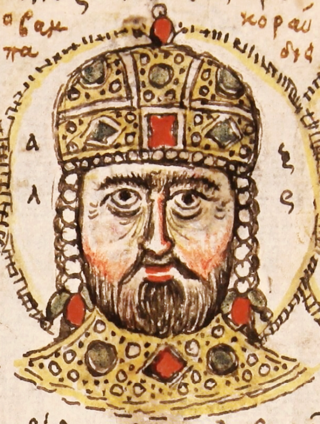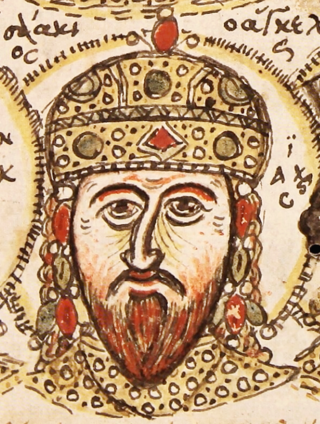See also
Surname list
This page lists people with the surname Angelina. If an internal link intending to refer to a specific person led you to this page, you may wish to change that link by adding the person's given name(s) to the link.
Angelina is a surname. It is the feminine form of the family name Angelos. Notable people with the surname include:

Alexios I Komnenos was Byzantine emperor from 1081 to 1118. Although he was not the first emperor of the Komnenian dynasty, it was during his reign that the Komnenos family came to full power and initiated a hereditary succession to the throne. Inheriting a collapsing empire and faced with constant warfare during his reign against both the Seljuq Turks in Asia Minor and the Normans in the western Balkans, Alexios was able to curb the Byzantine decline and begin the military, financial, and territorial recovery known as the Komnenian restoration. His appeals to Western Europe for help against the Turks was the catalyst that sparked the First Crusade.

Alexios III Angelos, Latinized as Alexius III Angelus, was Byzantine Emperor from March 1195 to 17/18 July 1203. He reigned under the name Alexios Komnenos, associating himself with the Komnenos dynasty. A member of the extended imperial family, Alexios came to the throne after deposing, blinding and imprisoning his younger brother Isaac II Angelos. The most significant event of his reign was the attack of the Fourth Crusade on Constantinople in 1203, on behalf of Alexios IV Angelos. Alexios III took over the defence of the city, which he mismanaged, and then fled the city at night with one of his three daughters. From Adrianople, and then Mosynopolis, he attempted unsuccessfully to rally his supporters, only to end up a captive of Marquis Boniface of Montferrat. He was ransomed and sent to Asia Minor where he plotted against his son-in-law Theodore I Laskaris, but was eventually captured and spent his last days confined to the Monastery of Hyakinthos in Nicaea, where he died.

Alexios V Doukas, in Latinised spelling Alexius V Ducas, was Byzantine emperor from February to April 1204, just prior to the sack of Constantinople by the participants of the Fourth Crusade. His family name was Doukas, but he was also known by the nickname Mourtzouphlos or Murtzuphlus (Μούρτζουφλος), referring to either bushy, overhanging eyebrows or a sullen, gloomy character. He achieved power through a palace coup, killing his predecessors in the process. Though he made vigorous attempts to defend Constantinople from the crusader army, his military efforts proved ineffective. His actions won the support of the mass of the populace, but he alienated the elite of the city. Following the fall, sack, and occupation of the city, Alexios V was blinded by another ex-emperor and later executed by the new Latin regime. He was the last Byzantine emperor to rule in Constantinople until the Byzantine recapture of Constantinople in 1261.

Isaac II Angelos or Angelus was Byzantine Emperor from 1185 to 1195, and again from 1203 to 1204.
The House of Komnenos, latinized Comnenus, was a Byzantine Greek noble family who ruled the Byzantine Empire in the 11th and 12th centuries. The first reigning member, Isaac I Komnenos, ruled from 1057 to 1059. The family returned to power under Alexios I Komnenos in 1081 who established their rule for the following 104 years until it ended with Andronikos I Komnenos in 1185. In the 13th century, they founded and ruled the Empire of Trebizond, a Byzantine rump state from 1204 to 1461. At that time, they were commonly referred to as Grand Komnenoi, a style that was officially adopted and used by George Komnenos and his successors. Through intermarriages with other noble families, notably the Doukas, Angelos, and Palaiologos, the Komnenos name appears among most of the major noble houses of the late Byzantine world.
Maria Komnene or Comnena may refer to:

Euphrosyne Doukaina Kamaterina or better Kamatera was a Byzantine Empress by marriage to the Byzantine Emperor Alexios III Angelos.

Irene Doukaina or Ducaena was a Byzantine empress by marriage to the Byzantine emperor Alexios I Komnenos. She was the mother of Emperor John II Komnenos and the historian Anna Komnene.
Anna Komnene Angelina or Comnena Angelina was an Empress of Nicaea. She was the daughter of the Byzantine Emperor Alexios III Angelos and of Euphrosyne Doukaina Kamatera.
John Doukas, Latinized as Ducas, was the eldest son of Constantine Angelos by Theodora Komnene, the seventh child of the Byzantine Emperor Alexios I Komnenos and Irene Doukaina. John Doukas took the family name of his grandmother Irene. He served as a military commander under Manuel I Komnenos and Isaac II Angelos. Isaac II, who was Doukas's nephew, raised him to the high rank of sebastokrator. Despite his advanced age, he continued to be an active general in the 1180s and 1190s, and until shortly before his death aspired to the imperial throne. He was the progenitor of the Komnenos Doukas line, which founded the Despotate of Epirus after the Fourth Crusade.
The House of Angelos, feminine form Angelina (Ἀγγελίνα), plural Angeloi (Ἄγγελοι), was a Byzantine Greek noble lineage which rose to prominence through the marriage of its founder, Constantine Angelos, with Theodora Komnene, the youngest daughter of Emperor Alexios I Komnenos. As imperial relatives, the Angeloi held various high titles and military commands under Emperor Manuel I Komnenos. In 1185, following a revolt against Andronikos I Komnenos, Isaac II Angelos rose to the throne, the first of three Angeloi emperors who ruled until 1204. The period was marked by the decline and fragmentation of the Byzantine Empire, culminating in its dissolution by the Fourth Crusade in 1204.
George Palaiologos or Palaeologus was a Byzantine general, one of the most prominent military commanders and supporters of Emperor Alexios I Komnenos.
Maria Doukaina Komnene Petraliphaina was the wife of Theodore Komnenos Doukas, ruler of Epirus and in 1224–1230 self-proclaimed Emperor of Thessalonica. She is the earliest consort of the Epirote state known by name: the two wives of Michael I Komnenos Doukas, predecessor of her husband, were members of the Melissenos family but their first names are unknown.
Theodora Komnene was a Byzantine noblewoman, being the fourth daughter of Emperor Alexios I Komnenos and Irene Doukaina. She married Constantine Angelos, by whom she had seven children. Byzantine emperors Alexios III Angelos and Isaac II Angelos were her grandsons, thereby making her an ancestor of the Angelos dynasty.

John Komnenos was a Byzantine aristocrat and military leader. The younger brother of Emperor Isaac I Komnenos, he served as Domestic of the Schools during Isaac's brief reign (1057–59). When Isaac I abdicated, Constantine X Doukas became emperor and John withdrew from public life until his death in 1067. Through his son Alexios I Komnenos, who became emperor in 1081, he was the progenitor of the Komnenian dynasty that ruled the Byzantine Empire from 1081 until 1185, and the Empire of Trebizond from 1204 until 1461.
Andronikos Doukas Angelos was a Byzantine aristocrat related to the ruling Komnenos dynasty. During the reign of his cousin, Manuel I Komnenos, he served without success as a military commander against the Seljuk Turks, and as envoy to the Kingdom of Jerusalem. Following Manuel's death, in 1182 he was sent to stop the rebellion of Andronikos I Komnenos, but was defeated and eventually defected to him. Shortly after, he led a failed conspiracy of leading aristocrats against Andronikos I. When it was discovered, Andronikos and his sons fled the Empire, ending up in Acre, where he died. He was the father of emperors Isaac II Angelos and Alexios III Angelos.
Constantine Angelos was a Byzantine aristocrat who married into the Komnenian dynasty and served as a military commander under Manuel I Komnenos, serving in the western and northern Balkans and as an admiral against the Normans. He was the founder of the Angelos dynasty, which went on to rule the Byzantine Empire in 1185–1204 and found and rule the Despotate of Epirus (1205–1318) and the Empire of Thessalonica (1224–1242/46).
Theodora Angelina Palaiologina was a Byzantine noblewoman and mother of the future Byzantine Emperor Michael VIII Palaiologos, the founder of the Palaiologan dynasty. She was the daughter of the despotes Alexios Palaiologos and Irene Komnene Angelina, the daughter of Alexios III Angelos and Euphrosyne Doukaina Kamatera.
Angelos was a Greek noble lineage which gave rise to three Byzantine emperors who ruled between 1185 and 1204.
Isaac Komnenos Vatatzes was a Byzantine aristocrat and military commander, who was the son-in-law of Emperor Alexios III Angelos and received the rank of sebastokrator.